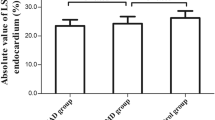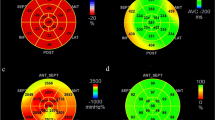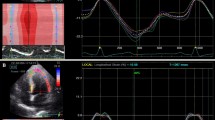Abstract
Purpose
The objective of this study was to investigate subclinical left ventricular dysfunction in patients diagnosed with myocardial infarction with non-occlusive coronary arteries (MINOCA).
Methods
Thirty-five patients with MINOCA (average age 54.26 ± 12.24 years) and thirty-five patients with ischemia with non-obstructed coronary artery disease (INOCA) (average age 55.20 ± 8.36 years) were enrolled in the study. All clinical conditions that could affect left ventricular functions were considered exclusion criteria. Echocardiographic studies were conducted in the patient and control groups in the left lateral decubitus position using a medical ultrasound device (EPIQ 7, Philips Medical System, USA). The left ventricle was examined longitudinally with apical images of chamber 4-3-2 using the available software (QLAB 6.0).
Results
There were no differences in age, blood pressure level, baseline echocardiogram measurements, and tissue Doppler parameters between the two groups. In two-dimensional speckle tracking echocardiography (2D-STE) measurements, left ventricular longitudinal strain and strain rate in systole, early and late diastole from apical 4-3-2 chamber and global measurements of each parameter were significantly decreased in the MINOCA group compared to the INOCA group (p < 0.05). A significant negative correlation was observed between the global longitudinal strain rate and the troponin I in the MINOCA patients group (r=-0.43 p = 0.009).
Conclusions
Our study showed that while standard echocardiographic parameters for patients diagnosed with MINOCA were normal, their left ventricular systolic and diastolic functions were reduced by the 2D-STE method.


Similar content being viewed by others
References
Niccoli G, Scalone G, Crea F (2015) Acute myocardial infarction with no obstructive coronary atherosclerosis: mechanisms and management. Eur Heart J 36:475–481. https://doi.org/10.1093/eurheartj/ehu469
Pasupathy S, Air T, Dreyer RP et al (2015) Systematic review of patients presenting with suspected myocardial infarction and nonobstructive coronary arteries. Circulation 131:861–870. https://doi.org/10.1161/CIRCULATIONAHA.114.011201
Pasupathy S, Tavella R, McRaeJohn S et al (2015) Myocardial Infarction With Non-Obstructive Coronary Arteries–Diagnosis And Management. Eur Cardiol Rev 10:79–82. https://doi.org/10.15420/ecr.2015.10.2.79
Pasupathy S, Tavella R, Beltrame JF (2017) Myocardial infarction with nonobstructive coronary arteries (MINOCA): the past, present, and future management. Am Heart Assoc 135:1490–1493. https://doi.org/10.1161/CIRCULATIONAHA.117.027666
Teske AJ, De Boeck BW, Melman PG et al (2007) Echocardiographic quantification of myocardial function using tissue deformation imaging, a guide to image acquisition and analysis using tissue Doppler and speckle tracking. Cardiovasc Ultrasound 5:1–19. https://doi.org/10.1186/1476-7120-5-27
Alderete JF, Torales JM, García LB et al (2018) Myocardial infarction and non-obstructive coronary arteries (MINOCA) associated to diastolic dysfunction of the left ventricle. J Cardiol Curr Resi 11:161–164. https://doi.org/10.15406/jccr.2018.11.00391
Inci S, Koryürek Ö, Nar G et al (2017) Psoriazis Vulgarisli Hastalarda Preklinik Sol Ventrikül Fonksiyon Bozukluğunun İki Boyutlu Speckle Tracking Ekokardiyografi ile Tespiti. Koşuyolu Heart Journal 20:40–46. https://doi.org/10.5578/khj.27644
Perk G, Tunick PA, Kronzon I (2007) Non-Doppler two-dimensional strain imaging by echocardiography–from technical considerations to clinical applications. J Am Soc Echocardiogr 20:234–243. https://doi.org/10.1016/j.echo.2006.08.023
Altiok E, Tiemann S, Becker M et al (2014) Myocardial deformation imaging by two-dimensional speckle-tracking echocardiography for prediction of global and segmental functional changes after acute myocardial infarction: a comparison with late gadolinium enhancement cardiac magnetic resonance. J Am Soc Echocardiogr 27:249–257. https://doi.org/10.1016/j.echo.2013.11.014
Kang Y, Xu X, Cheng L et al (2014) Two-dimensional speckle tracking echocardiography combined with high-sensitive cardiac troponin T in early detection and prediction of cardiotoxicity during epirubicine-based chemotherapy. Eur J Heart Fail 16:300–308. https://doi.org/10.1002/ejhf.8
Russo C, Jin Z, Elkind MS et al (2014) Prevalence and prognostic value of subclinical left ventricular systolic dysfunction by global longitudinal strain in a community-based cohort. Eur J Heart Fail 16:1301–1309. https://doi.org/10.1002/ejhf.154
Inci S, Gül M, Alsancak Y et al (2019) Short-and mid‐term effects of sleeve gastrectomy on left ventricular function with two‐dimensional speckle tracking echocardiography in obese patients. Echocardiography 36:2019–2025. https://doi.org/10.1111/echo.14522
Bairey Merz CN, Pepine CJ, Walsh MN et al (2017) Ischemia and no obstructive coronary artery disease (INOCA): developing evidence based therapies and research agenda for the next decade. Circulation 135:1075–1092. https://doi.org/10.1161/CIRCULATIONAHA.116.024534
Quinones MA, Otto CM, Stoddard M et al (2002) Recommendations for quantification of Doppler echocardiography: A report from the Doppler Quantification Task Force of the Nomenclature and Standards Committee of the American Society of Echocardiography. J Am Soc Echocardiogr 15:167–184. https://doi.org/10.1067/mje.2002.120202
Lang RM, Badano LP, Mor-Avi V et al (2015) Recommendations for cardiac chamber quantification by echocardiography in adults: an update from the American Society of Echocardiography and the European Association of Cardiovascular Imaging. J Am Soc Echocardiogr 28:1–39. https://doi.org/10.1093/ehjci/jev014
Simsek E, Sari C, Kucukokur C et al (2021) Endothelial dysfunction in patients with myocardial ischemia or infarction and nonobstructive coronary arteries. J Clin Ultrasound 49:334–430. https://doi.org/10.1002/jcu.22902
Gehrie ER, Reynolds HR, Chen AY et al (2009) Characterization and outcomes of women and men with non–ST-segment elevation myocardial infarction and nonobstructive coronary artery disease: results from the Can Rapid Risk Stratification of Unstable Angina Patients Suppress Adverse Outcomes with Early Implementation of the ACC/AHA Guidelines (CRUSADE) quality improvement initiative. Am Heart J 158:688–694. https://doi.org/10.1016/j.ahj.2009.08.004
McCabe JM, Armstrong EJ, Kulkarni A et al (2012) Prevalence and factors associated with false-positive ST-segment elevation myocardial infarction diagnoses at primary percutaneous coronary intervention–capable centers: a report from the Activate-SF registry. Archives of internal medicine 172:864–871. https://doi.org/10.1001/archinternmed.2012.945
Beltrame JF (2013) Assessing patients with myocardial infarction and nonobstructed coronary arteries (MINOCA). J Intern Med 273:182–185. https://doi.org/10.1111/j.1365-2796.2012.02591.x
Bittencourt MS, Hulten E, Ghoshhajra B et al (2014) Prognostic value of nonobstructive and obstructive coronary artery disease detected by coronary computed tomography angiography to identify cardiovascular events. Circ Cardiovasc Imaging 7:282–291. https://doi.org/10.1161/CIRCIMAGING.113.001047
Chow BJ, Small G, Yam Y et al (2015) Prognostic and therapeutic implications of statin and aspirin therapy in individuals with nonobstructive coronary artery disease: results from the CONFIRM (COronary CT Angiography EvaluatioN For Clinical Outcomes: An InteRnational Multicenter registry) registry. Arterioscler Thromb Vasc Biol 35:981–999. https://doi.org/10.1161/ATVBAHA.114.304351
Lin FY, Shaw LJ, Dunning AM et al (2011) Mortality risk in symptomatic patients with nonobstructive coronary artery disease: a prospective 2-center study of 2,583 patients undergoing 64-detector row coronary computed tomographic angiography. J Am Coll Cardiol 58:510–559. https://doi.org/10.1016/j.jacc.2010.11.078
Ibanez B, James S, Agewall S, et al et al (2017) 2017 ESC Guidelines for the management of acute myocardial infarction in patients presenting with ST-segment elevation: The Task Force for the management of acute myocardial infarction in patients presenting with STsegment elevation of the European Society of Cardiology (ESC). Eur Heart J 39:119–177. https://doi.org/10.1093/eurheartj/ehx393
Nelson MD, Szczepaniak LS, Wei J et al (2014) Diastolic dysfunction in women with signs and symptoms of ischemia in the absence of obstructive coronary artery disease: a hypothesis-generating study. Circ Cardiovasc Imaging 7:510–516. https://doi.org/10.1161/CIRCIMAGING.114.001714
Choi YJ, Park JB, Park CS et al (2021) Prognostic implications of left ventricular mass-geometry in patients with no or nonobstructive coronary artery disease. BMC Cardiovasc Disord 21:1–9. https://doi.org/10.1186/s12872-021-02005-6
Gul M, Inci S, Aktas H et al (2021) Hidden danger of COVID-19 outbreak: evaluation of subclinical myocardial dysfunction in patients with mild symptoms. Int J Cardiovasc Imaging 37:2957–2964. https://doi.org/10.1007/s10554-021-02318-9
Sitia S, Tomasoni L, Cicala S et al (2012) Detection of preclinical impairment of myocardial function in rheumatoid arthritis patients with short disease duration by speckle tracking echocardiography. Int J Cardiol 160:8–14. https://doi.org/10.1016/j.ijcard.2011.03.012
Da Costa A, Isaaz K, Faure E et al (2001) Clinical characteristics, aetiological factors and long-term prognosis of myocardial infarction with an absolutely normal coronary angiogram; a 3-year follow-up study of 91 patients. Eur Heart J 22:1459–1465. https://doi.org/10.1053/euhj.2000.2553
Libby P, Pasterkamp G (2015) Requiem for the “vulnerable plaque”. Eur Heart J 36:2984–2987. https://doi.org/10.1093/eurheartj/ehv349
Crea F, Lanza GA, Camici PG (2014) Coronary microvascular dysfunction. In: Braunwald E (ed) Mechanisms of Coronary Microvascular Dysfunction, 1st edn. Springer, Milano, pp 31–47
Fuster V, Walsh R, Harrington R (2014) Hurst’s The Heart, 13th edn. Ankara. The McGraw-Hill, pp 1238–1242
Wang J, Khoury DS, Yue Y et al (2008) Preserved left ventricular twist and circumferential deformation, but depressed longitudinal and radial deformation in patients with diastolic heart failure. Eur Heart J 29:1283–1289. https://doi.org/10.1093/eurheartj/ehn141
Yip GW, Zhang Q, Xie JM et al (2011) Resting global and regional left ventricular contractility in patients with heart failure and normal ejection fraction: insights from speckle-tracking echocardiography. Heart 97:287–294. https://doi.org/10.1136/hrt.2010.205815
Polonski L, Gasior M, Gierlotka M et al (2011) A comparison of ST elevation versus non-ST elevation myocardial infarction outcomes in a large registry database: are non-ST myocardial infarctions associated with worse long-term prognoses? Int J Cardiol 152:70–77. https://doi.org/10.1016/j.ijcard.2010.07.008
Terkelsen CJ, Lassen JF, Norgaard BL et al (2005) Mortality rates in patients with ST-elevation vs. non-ST-elevation acute myocardial infarction: observations from an unselected cohort. Eur Heart J 26:18–26
Bueno H, Bugiardini R, Carerj S et al (2016) 2015 ESC guidelines for the management of acute coronary syndromes in patients presenting without persistent ST-segment elevation. Eur Heart J 37:267–315. . doi:10.1093/eurheartj/ehv320
Acknowledgements
None Conflict of interest: None.
Funding
None.
Author information
Authors and Affiliations
Contributions
Sinan Inci: Conceptualization, Data curation, Formal analysis, Writing original draft.
Murat Gul: Methodology, Formal analysis, Writing original draft.
Deniz Elcik: Investigation, Data curation, Validation.
Halil Aktas: Methodology, Data curation.
Oguz Yildirim: Investigation, Validation, Data curation.
Saban Kelesoglu: Investigation, Validation, Writing, Review & Editing.
Nihat KALAY: Project administration, Review & Editing.
Corresponding author
Ethics declarations
Funding
The authors declare that no funds, grants, or other support were received during the preparation of this manuscript.
Conflict of interest
/Competing interests: The authors have no relevant financial or non-financial interests to disclose.
Ethics approval:
This study was performed in line with the principles of the Declaration of Helsinki. Approval was granted by the Clinical Research Ethics Committee of University Erciyes (Date:29.04.2020/No:2020/205).
Informed consent:
The informed consent was taken from all patients, and the study was approved by the local ethics committee (No: 2020/205, Date: 29.04.2020).
Additional information
Publisher’s Note
Springer Nature remains neutral with regard to jurisdictional claims in published maps and institutional affiliations.
Rights and permissions
About this article
Cite this article
INCI, S., GUL, M., ELCIK, D. et al. Identification of subclinical myocardial dysfunction by Speckle Tracking Imaging in patients with myocardial infarction with non-occlusive coronary arteries (MINOCA). Int J Cardiovasc Imaging 38, 2099–2106 (2022). https://doi.org/10.1007/s10554-022-02602-2
Received:
Accepted:
Published:
Issue Date:
DOI: https://doi.org/10.1007/s10554-022-02602-2




